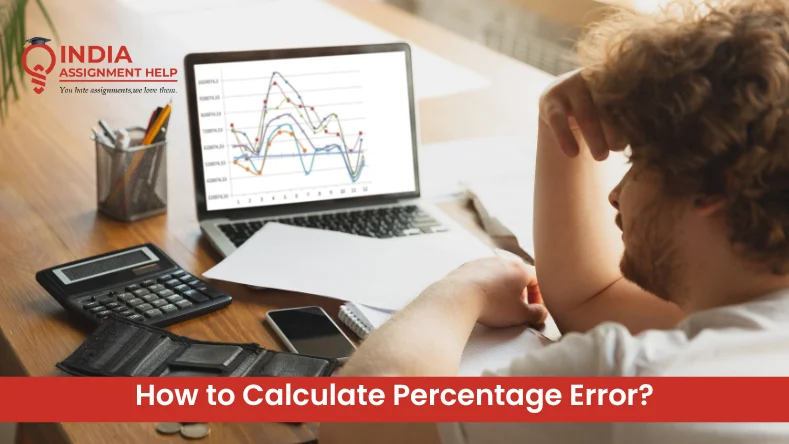How to Calculate Percentage Error?

Whenever asked a question with applied computation, we answer it with an estimation. Something as easy as “How far is the gas station?” The most common answer is it’s 500 metres away or a few kilometres away. There’s always a difference between the actual and estimated data.
Calculating the error percentage in data, the difference between the estimated answers and the actual answer is calculated using the percentage error formula. There are many reasons for such errors to arise, gaps in data points, bias in the calculation, or instrumental factors.
Before any vaccine/drug is released on the market, scientists statistically test its effectiveness and calculate the error percentage. - Medium
It is expected and common for such errors to arise. Researchers present the result after eliminating the errors via calculation or defining the percentage error. It is an unavoidable step in data collection and scientific calculation. A smaller error value means the result is closer to the actual value. Here’s where calculating the percentage error comes to play. Let’s learn how to calculate it.
What is the percentage error formula?
The percentage error formula is:
Percentage Error = Absolute Difference / Accepted Value×100
Here,
- The accepted value is a certain value that is regarded as true in an experiment. It is a predefined theoretical value that is taken into account when calculating the result of an experiment. Prominently used for scientific calculations in chemistry.
- The difference between the result of the experiment and the accepted value gives an absolute error. It gives an idea of how the accepted value and calculated value differ.
Tip: If the extracted value is lower than the standardly accepted value, then the percentage error will be a negative value. However, such values are not common but are still acceptable.
So, per cent error is the ratio of the absolute difference and the accepted value multiplied by 100. The result of the percentage error is usually a positive number. But, when calculated without an absolute value, the result may be positive or negative. When calculating the result of an experiment, this step is a must; let's learn using this formula step by step.
Have troubles with your calculations? Can't find the error in your calculations, no matter how many times you redo them? Don’t fret, as we have a team of professional mathematicians that can help you overcome such issues. Just fill out the enrollment form to get statistics assignment help and free academic resources from our vast digital library.
What are the steps to use the percentage error formula?
Here’s how to use this formula, step-by-step:
Step 1: Finding the absolute difference
You will first need to find the absolute difference. For calculating the absolute difference, subtract the experimental value from the accepted/theoretical value. An example of absolute value is the boiling point of water is 212°F or 100 °C.
Step 2: Find the absolute difference to the accepted value ratio
Divide the absolute difference (the value we calculated in step 1) by the accepted value. Don’t use the value you extracted as your experiment’s result. The answer will be a decimal number, and generally, it is a positive number.
Step 3: Converting into a percentage
To convert any value into a percentage, we multiply it by 100. Do the same when calculating the percentage error. Multiply the answer obtained in step 2 by a hundred, and the answers can be expressed in percentage form.
Step 4: Reporting the answer
When reporting the answer (result obtained in step 3), add a % as the error value is now expressed in percentage.
Organising the data into tangible sets is useful for reducing errors. It is of so much importance that eighty per cent of the time of a data scientist is spent on organising the data sets and only twenty per cent on data analysis. - Infoworld
Follow these four steps for calculating the percentage error in your data. Keep in mind that, even though the answer is mostly a positive number but a negative answer value is also accepted. A positive symbol represents that the calculated value is more than the actual value, and vice versa.
How do we increase precision in statistics?
The main purpose of using the percentage error formula is to beat errors in your calculations. But, apparent errors arise even before the result is extracted. As discussed earlier, the many reasons for errors in data include instrumentation errors, low precision, and human error. So here are a few tips to improve precision for minimising errors:
Increase the sample size
This is one of the most commonly used methods in any experiment or statistical analysis. Increasing data points or sample size helps in reducing errors by a manifold. The only downside is that the calculation might become more complex, considering many points.
Reduce variability
Decreasing variability means decreasing the standard deviation. The lower the variability of data points from the centre, the lower the chances of error. Improving the process of data collection or instrument precision helps reduce variability.
Use a one-sided confidence interval.
A confidence interval is a range assumed within which the actual value lies. Using a one-sided confidence interval is better than a two-sided one. Such a method is quite useful for lowering the bias as it is independent of the variable's other side (the other axis on the x-y plane).
Lower the confidence level
The next useful method is lowering the confidence margin. Commonly, the confidence interval is assumed to be 95%. Lowering this interval will increase precision and make extracting the parameter you seek easier.
Decreasing Instrument/Human Error
Last but not least, lowering the errors caused by instrument or human error is useful for reducing the error. Checking the instrument before collecting the data and carrying out the procedure for data collection with precision is key.
Did you know that there are over 400K bytes of data per sand gain on Earth?
These are the most effective methods for reducing errors in a statistical calculation. Errors can be reduced right from data collection, and many machines are being developed to reduce the error percentage. Using decision aids and following the standard method to the dot can also help.
The equal dispersion of data error is important for neutralising the after-effects of the error on the outcome. It is especially important in experiments or an implied dataset. Moreover, it is important to reduce decision errors and reduce the chances of inaccurate results. Using the percentage error formula helps report the error and address if there's a need for experimenting again.
Statistics is a field that you will be using throughout your academic and professional career, as all professional fields require statistical skills. Get statistics assignment help from our experts to overcome your lack of statistics concepts and nail your assignments. You may fill out the form to get in contact with academic writing makers and get free academic resources from our vast digital library.





